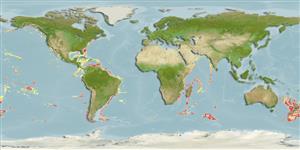>
Gadiformes (Cods) >
Macrouridae (Grenadiers or rattails)
Etymology: Kuronezumia: Japanese, kuronezumia = black mouse or rat. Personnal communication of Tomio I. Curator in the Calif. Academy of Sciences, Ichthyology.
More on author: Iwamoto.
Environment: milieu / climate zone / depth range / distribution range
Ökologie
seewasser benthopelagisch; tiefenbereich 585 - 1300 m (Ref. 58302). Deep-water
Western Atlantic, Western Indian Ocean, and the Pacific Ocean.
Size / Gewicht / Alter
Maturity: Lm ? range ? - ? cm
Max length : 60.0 cm TL Männchen/unbestimmt; (Ref. 11953)
No enlarged scutes at snout tip; suborbital ridge not developed; underside of snout narrowly naked along upper lip; 1-2 scales on branchiostegal membrane; ventral light organ very large (Ref. 13608).
A benthic species found on the continental slope (Ref. 75154).
Life cycle and mating behavior
Geschlechtsreife | Fortpflanzung | Ablaichen | Eier | Fecundity | Larven
Iwamoto, T. and E. Anderson, 1994. Review of the grenadiers (Teleostei: Gadiformes) of southern Africa, with descriptions of four new species. Ichthyol. Bull. J.L.B. Smith Inst. Ichthyol. (61):1-28. (Ref. 11953)
IUCN Rote Liste Status (Ref. 130435: Version 2024-1)
Bedrohung für Menschen
Harmless
Nutzung durch Menschen
Tools
Zusatzinformationen
Download XML
Internet Quellen
Estimates based on models
Preferred temperature (Ref.
123201): 2.5 - 9.5, mean 6.1 °C (based on 370 cells).
Phylogenetic diversity index (Ref.
82804): PD
50 = 0.5312 [Uniqueness, from 0.5 = low to 2.0 = high].
Bayesian length-weight: a=0.00214 (0.00109 - 0.00421), b=3.20 (3.03 - 3.37), in cm total length, based on LWR estimates for this (Sub)family-body shape (Ref.
93245).
Trophic level (Ref.
69278): 3.6 ±0.5 se; based on size and trophs of closest relatives
Widerstandsfähigkeit (Ref.
120179): sehr niedrig, Verdopplung der Population dauert mehr als 14 Jahre. (Preliminary K or Fecundity.).
Fishing Vulnerability (Ref.
59153): Moderate vulnerability (44 of 100).
